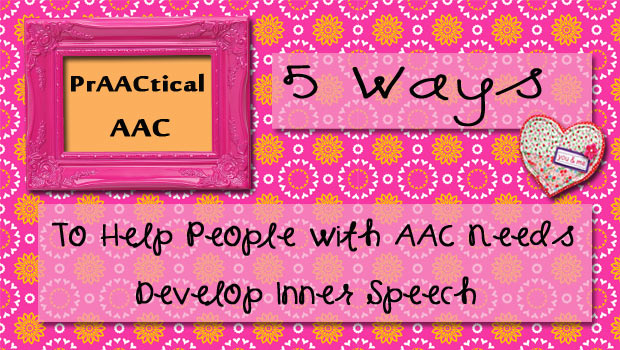February 23, 2012
by Carole Zangari -

“If you think you are too small to be effective, you have never been in bed with a mosquito.” Betty Reese – Little things can make or break a good streak of AAC implementation. Here are some things that we’ve come to appreciate. They’re small in size, expense, or time demands but pay off in a big way. – 1. Wait time: There’s nothing like a 10-second expectant pause and controlled access to help someone learn to respond without more intrusive prompts. – 2. Clear plastic jars with screw-on lids (nothing beats these for limiting access so that kids are tempted to make a request) – 3. Button covers for the iPad, like these from BubCap. Amazing how a tiny piece of plastic can keep an activity or conversation from derailing. – 4. Bragging (authentically) about a colleague. “Ms. Mama, I have to tell you how awesome Polly Para was... [Read More...]
February 21, 2012
by Robin Parker -

Communication and language involves so much more than requesting. Without much effort, communicators with typical language development and even delayed language development communicate for many reasons. Showing or telling about a shared interest comes easily and is a form of commenting to communicate. Commenting is one of the most social reasons that we communicate. So, it makes perfect sense that children with social communication disorders may not have an easy time with these social aspects of communication and language. We know many children who frequently use long (or short) sentences to say ‘I want the blue truck’, ‘I want the big ball’, or even ‘Can I have the cold drink’. They may even communicate frequently to ask for toys, games, or activities of their choice. All of the requesting is GREAT but not enough to be part of comprehensive conversations and social language interactions. It is not that children with... [Read More...]
February 20, 2012
by Carole Zangari -

Recent research has strengthened this clinician’s belief that developing inner speech is an important strategy for many people who use AAC and are working to build their literacy skills. But how do we teach someone to develop that inner voice? Here are some ideas. – 1. Begin by using a ‘think aloud’ strategy to make your internal thought processes obvious to the person who uses AAC. Articulating your thoughts as you work through different communication and literacy learning processes gives the learner insight into what you are thinking. Once they are used to that, it is easier to introduce the concept of private/inner speech. – 2. Use explicit instruction. “Say it to yourself.” “Say it in your head.” Using natural gestures, like tapping your temple, can be helpful as well. We’ve found that this allows us to reduce the prompting over time. Fade the verbal prompt and continue the gestural one,... [Read More...]
January 23, 2012
by Robin Parker -

AAC & The Art of the Unconventional Conversation, Carole’s post from Saturday, recounts a young girl who some people might have thought was not ready for AAC. It reminds me a young man I know, Michael. I met Michael when he was 14, after he was discharged from all of his communication intervention or I should say his speech-language therapy sessions. He was discharged at school because when he moved from his autism classroom in middle school to a high school classroom for children with varying exceptionalities, it was ‘felt’ that he did not need it anymore. He had not made ‘progress’ in his speech and language goals, he did not talk, he did not consistently identify objects, and he did not essentially do a lot of things. He was discharged from his private therapy as he was not making progress in a lot of goals there either. Everyone... [Read More...]



